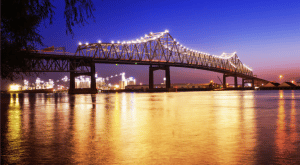Waterfront Living – Where Should You Live?
Something about being close to water, be it a river, ocean, or lake, makes you feel alive. The sound of the water rushing by, the smell of the salt in the air, and the feeling of being surrounded by nature are truly invigorating. This Buyer’s Guide for Waterfront Living will help you identify areas that offer a wide choice of frontage on the water.
The price of waterfront homes in the US can vary greatly depending on the location. For example, riverfront homes in rural areas may be less costly than oceanfront homes in more developed regions. However, prices for waterfront homes tend to be higher than non-waterfront homes due to their desirability and limited availability.
One of the main factors that will affect a waterfront home‘s price is the property’s size. Acreage ranges for waterfront homes can differ greatly, from just a few acres to hundreds of acres. The larger the property, the more expensive it will be. Another factor that can affect the price is the type of water frontage.
Waterfront homes are often considered luxurious purchases, and their prices reflect that. However, various waterfront homes are available at different price points to fit any budget. Whether you’re looking for a small riverfront cabin or a large oceanfront estate, there’s a waterfront home for you.
The US has the most coastline of any country in the world, with over 12,000 miles of coastline. It is home to some of the most beautiful beaches and coastlines in the world, from the East Coast to the West Coast. There is a never-ending supply of coastline to explore in the US.
Oceanfront Living Buyer’s Guide
Oceanfront homes on the east coast tend to be more expensive than those on the west coast. This is due to a number of factors, including population density and the proximity to major cities.
The type of waterfrontage also plays a role in determining the price of a waterfront home. Homes with direct oceanfront access are typically more expensive than those with indirect access or no access at all.
Oceanfront Properties by State:
Delaware’s coastline, at 28 miles, is the shortest of any oceanfront state.
Maine – With over 5,000 miles of coastline, Maine is home to some of the most beautiful and rugged coastlines in the world. From the rocky shores of Acadia National Park to the sandy beaches of Ogunquit, there is something for everyone to enjoy along Maine’s coast.
California – California is home to over 1,100 miles of coastline. From the rocky shores of Big Sur to the sandy beaches of Santa Barbara, there is no shortage of coastline to explore in California.
Connecticut – Connecticut is home to over 100 miles of coastline. From the beaches of Mystic to the shores of Old Saybrook, there is no shortage of things to see and do along Connecticut’s coast.
Florida – Florida is well-known for its stunning beaches and clear blue waters. With over 825 miles of coastline, Florida has something for everyone. From the white sand beaches of the Panhandle to the lively shores of Miami, there is no shortage of fun to be had in Florida.
Georgia – Georgia is home to over 100 miles of coastline. From the Golden Isles to Tybee Island, there is no shortage of things to see and do along Georgia’s coast.
Hawaii – With over 750 miles of coastline, Hawaii is a paradise for beach lovers. From the green sands of Maui to the black sand beaches of Hawaii Island, there is no shortage of beauty to be found along Hawaii’s coast.
Louisiana’s coastline is the third longest, at just over 320 miles. The state is home to several major port cities, including New Orleans and Baton Rouge.
Maine – Maine is home to over 3,500 miles of coastline. From the beaches of Portland to the shores of Acadia National Park, there is no shortage of things to see and do along Maine’s coast.
Maryland – Maryland is home to over 3,000 miles of coastline. From the Chesapeake Bay to the Atlantic Ocean, there is no shortage of things to see and do along Maryland’s coast. Delaware – Delaware is home to over 100 miles of coastline. From the beaches of Lewes to the shores of Rehoboth Beach, there is no shortage of things to see and do along Delaware’s coast.
Massachusetts – Massachusetts is home to over 500 miles of coastline. From the beaches of Cape Cod to the shores of Boston, there is no shortage of things to see and do along Massachusetts’ coast.
New Hampshire – New Hampshire is home to over 18 miles of coastline. From the beaches of Hampton to the shores of Lake Winnipesaukee, there is no shortage of things to see and do along New Hampshire’s coast.
New Jersey – New Jersey is home to over 130 miles of coastline. From the beaches of Cape May to the shores of Sandy Hook, there is no shortage of things to see and do along New Jersey’s coast.
New York – New York is home to over 1,000 miles of coastline. From the beaches of Long Island to the shores of Niagara Falls, there is no shortage of things to see and do along New York’s coast.
North Carolina – North Carolina is home to over 300 miles of coastline. From the Outer Banks to the Crystal Coast, there is no shortage of things to see and do along North Carolina’s coast.
Oregon’s coastline comes in second place, at just over 363 miles. The state’s coastline is known for its dramatic cliffs and rocky shores, as well as its iconic lighthouse at Cape Meares.
Rhode Island – Rhode Island is home to over 400 miles of coastline. From the beaches of Narragansett to the shores of Newport, there is no shortage of things to see and do along Rhode Island’s coast.
South Carolina – South Carolina is home to over 200 miles of coastline. From the beaches of Charleston to the shores of Hilton Head, there is no shortage of things to see and do along South Carolina’s coast.
Texas has the longest oceanfront coastline in the contiguous United States. At nearly 800 miles long, the Texas coast stretches from the Sabine River on the border with Louisiana all the way down to Brownsville on the Mexican border.
Vermont – Vermont is home to over 100 miles of coastline. From the beaches of Burlington to the shores of Lake Champlain, there is no shortage of things to see and do along Vermont’s coast.
Virginia – Virginia is home to over 3,000 miles of coastline. From the Chesapeake Bay to the Atlantic Ocean, there is no shortage of things to see and do along Virginia’s coast.
Riverfront Living
There are many US states with major riverfront real estate. Some of these states include Alabama, Arkansas, Colorado, Idaho, Illinois, Iowa, Kansas, Minnesota, Missouri, Montana, Nebraska, Nevada, New Mexico, North Dakota, Oklahoma, Oregon, South Dakota, Utah, Washington, and Wyoming. Each state has its own unique riverfront property offerings.
The Mighty Mississippi River is the largest river in the United States and flows through ten states including, Illinois, Kentucky, Missouri, Arkansas, Tennessee, Mississippi, Louisiana, Minnesota, Iowa, and Wisconsin.

The Colorado River is the 18th longest river in the US and flows through seven southwestern states including Wyoming, Colorado, Utah, New Mexico, Nevada, Arizona, and California.
Other large rivers in the US include the Susquehanna River (Pennsylvania), the Hudson River (New York), and the Rio Grande (Texas).
Lakefront Living
The United States is home to some of the largest lakes in the world. Here are five of the largest:
Lake Superior: This freshwater lake is the largest in the world by area, and it borders Wisconsin, Michigan, Minnesota, and Ontario.
Lake Huron: The second-largest freshwater lake in the world, Lake Huron borders Michigan and Ontario.
Lake Michigan: The third-largest freshwater lake in the world, Lake Michigan is completely contained within the United States and borders Illinois, Indiana, and Wisconsin.
Lake Erie: The fourth-largest freshwater lake in the world, Lake Erie borders New York, Pennsylvania, Ohio, and Ontario.
Lake Ontario: The fifth-largest freshwater lake in the world, Lake Ontario borders New York and Ontario.
In summary — There are many factors that can affect the price of a waterfront home.
- The location of the waterfront property is a big deal.
- The size of the property, the type of water frontage, and the location all play a role in determining the price.
- Oceanfront homes on the east coast tend to be more expensive than those on the west coast.
- Properties located in popular vacation destinations or near major cities will typically be more expensive than those in more rural areas.
- Waterfront properties located in areas with harsh winters may also be less expensive than properties in warmer climates.
- Depending on the type of waterfront property, weather can be a major factor. Consider the potential for storm damage.


